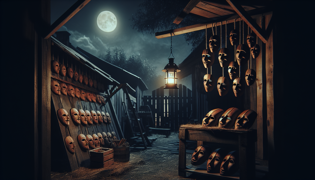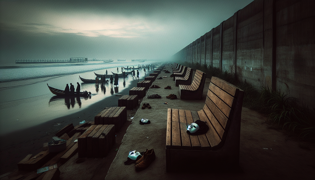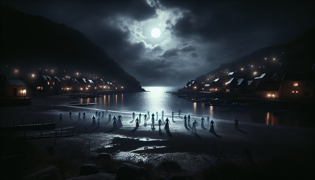Introduction
Beneath a velvet sky studded with distant stars, the fishing village of Dennery hushes itself in anticipation. Palm fronds tremble in the salt–heavy breeze, carrying the soft echo of waves against the shore. Lanterns glow dimly in wooden verandas, where elders lean forward to recall a ritual older than memory. Each December, when the nights stretch longest, whispers circulate of phantom masqueraders who will soon emerge to haunt the narrow streets. Mothers hush children beside hearth fires, urging them to slumber before the moon dips low. The scent of allspice and ginger drifts from kitchens where meals are prepared hurriedly—beans and rice for offerings, coconuts split for water. Nobody claims to know where these spirits come from. Some say they are ancestors denied proper burial, others believe they sprang from a pact with wandering drum spirits lured by the breeze. Yet no villager dares remain awake past midnight. When the hour arrives, a distant drumbeat veils the air. Echoing footsteps fall like rain on rooftops. A hush descends, more chilling than the night air itself, then rises again in a chorus of whispered chants. Houses tremble. Doors lock. Hearts pound with equal measures of fear and fascination. For in that moment, every living soul understands that the Midnight Masquerade is not a dream or superstition—it is a manifestation of Dennery’s own memory, a tapestry woven from courage, sacrifice, and ancient rites that refuse to fade.
Origins of the Ghostly Revelers
Long before modern streetlights and paved roads, Dennery was a cluster of wooden cottages and coconut palms, bound to the sea by nets and tales spun around firelight. In those days, when a villager died far from home—at sea or in foreign towns—their body might never return. Families fashioned a makeshift grave mound on the shore or within a hidden grove inland. Over time, these unmarked resting places gave rise to restless spirits, tangled between earth and memory.
It was said that the original masqueraders were couriers—shape–shifting messengers chosen by ancestral councils. Each wore a mask carved from red cedar, painted with swirling patterns of white and black, emblematic of life and death in fragile balance. As midnight approached on the winter solstice, the masks came alive, guided by the chant of ancestral drums. Villagers reported glimpses of flickering lanterns weaving through palm groves, voices rising and falling in an otherworldly hymn that carried across the lagoon.

Scholars who later recorded these accounts speculated on the blend of African, Carib, and European influences that fused in Dennery’s myth–making. They traced motifs of masquerade to West African Egungun traditions—masked spirits of the departed who return during annual festivals to bless the living. Equally, the rhythmic pulse of drums and the carnival aesthetic tied back to the French and British colonizers who once held sway over the island. Yet only in Dennery did the masquerade take on a shape truly its own: nocturnal, ethereal, and unbound by calendars.
By the mid–twentieth century, electricity crept into Dennery, and radio broadcasts crackled with Christmas tunes. Still, the oldest families insisted on keeping windows shuttered and shutters bolted on the night of the masquerade. They spoke of a pact never broken, a covenant between the living and the dead: each year, at the darkest hour, the fugitives of time gather to dance, remind the living of past debts, and restore equilibrium between worlds.
In hushed tones, elders recount the day when young Marcel Romain followed the blue glow of a lantern down a deserted path, hoping to glimpse the masqueraders. His screams echoed until dawn when villagers found only his trampled hat beneath a twisted almond tree. From that moment, the legend hardened into law: no child, no traveler, no curious soul may roam the streets when drums begin to speak.
And speak they do. The drums themselves hold secrets buried in salt and mahogany. When the moon hangs low and tides slacken, every pulse seems to articulate a phrase in an ancient tongue: “We are here. We remember. We beckon you beyond.” The carnival costumes—tattered yet glowing—reflect moonbeams on masks that never smile and eyes that burn with unspoken longing.
Each February, scholars from Castries ascend the coast to interview the last surviving mask–makers, those who still understand the sacred formulas of pigment and woodgrain that give each mask its power. Their workshops lie behind faded shutters festooned with chicken bones and dried plantains. They work with silent reverence, cutting cedar by candlelight, whispering protective charms over each stroke of black and white paint.
No one claims to have captured the masquerade on film or in a photograph. Cameras—or so they say—will jam or the film bleeds black. Only stories endure, carried by seasonal winds down to the sugarcane fields and whispered in night markets. For Dane Pierre, a young teacher who arrived eager to document folklore, the masquerade remained a frustrated obsession until his final lantern flicker at sunrise—when he, too, vanished without trace.
Thus the mystery deepened. Each generation contributes a new chapter of sighting, loss, or interpretation, binding Dennery more tightly to its own legend. And so, the midnight revelers remain timeless, offering both warning and invitation to all who tread their silent parade.
Midnight Drumbeat and the Enchanted Procession
When the clock tower in Dennery strikes twelve, the island holds its breath. From a distant grove a lone drumbeat begins—soft, measured, like a heartbeat calling the fleshward to join the spiritward. The rhythm grows, first a quartet of dancers echoing the pulse, then a throng that rises like tidewater surging inland.
No one sees the first reveler’s foot step onto the cobblestones. One moment the lane lies empty beneath electric light; the next, a figure appears, mask glinting, arm raised to signal the next in line. He moves with silent grace, each pirouette precise as carved marble. Then come two more—one whose mask carries the twisted bough of an almond tree, the other whose maracas ring clear as chapel bells.

The procession swells until fifty or more silhouettes drift in the ghost–white glow of the moon. Their movements are choreographed yet fluid, as if guided by currents of wind and memory. They never speak; their drumming and whispers are incantations that fuse into a hum resonating through walls and chavannes.
By design, the masqueraders avoid open squares where streetlamps burn brightest. Instead, they wind through alleys lined with bougainvillea, slip beneath archways draped with fishing nets, and hover at doorsteps where terrified villagers peer through slats. No home is immune. If a family dares venture to the threshold, they glimpse gaunt hands offering woven baskets filled with yarb leaves and glowing coals. To refuse is taboo; gifts placed before an unlit candle will burn by dawn regardless.
Children who break their parents’ warnings have vanished, and elders swear they hear muffled footsteps trailing them when the masquerade passes. One young girl, Estelle, dared to follow a fatherly masked figure for two blocks. He guided her to a clearing near the lagoon, touched her brow gently, and whispered a word she finally recalled at sunrise: “Remember.” When she rejoined her family, her hair had streaks of silver she could never remove.
As the procession marches, the drumming intensifies in complexity. Beat shifts between tom–tom, bass, and snare woven in patterns that defy conventional rhythm. Some say each composition encodes the story of a lost soul finding redemption, while others believe the drummers channel voices of the deceased, using the signal to cross between worlds.
A hush follows the final crescendo. The dancers form a circle in the village square, masks tilted skyward. Moonlight pours through the opening above, illuminating their features in stark relief. Then, in a moment both still and electric, they kneel with offerings—a snap of calabash gourds, handfuls of allspice, a handful of sands from the oldest bench by the sea.
Before anyone can approach, the masqueraders rise and move on, resuming their steps in perfect unison. The procession continues until the first hint of dawn tints the eastern horizon. By the time roosters crow in distant courtyards, the lane lies empty once more, lanterns swinging, masks left behind as silent relics on stone walls.
Those masks, worn by faceless revenants, become relics—guarded by select families until they crumble. But the legend never fades: each sunrise births fresh rumors of minute changes in the masks’ paint, a new ghost at a window, or the distant echo of drums carried on the wind.
Dawn, Redemption, and the Legacy of Masks
At the first cry of a rooster, the masquerade dissolves like smoke. The masked dancers vanish into thin air or retreat into thickets behind the cottages. Only the fading drumbeat lingers, softened by distance and the rising sun. Villagers emerge with cautious steps, eavesdropping on silent streets where footprints have already begun to blur.
Early risers find offerings scattered on thresholds and dusty benches: tamarind pods, guava leaves, salted cod wrapped in banana leaves. Some claim these tokens bring protection, while others believe they seal a pact of remembrance between worlds. Those brave enough to retrieve them handle each gift with reverence, speaking a quick prayer to both departed and living.

In the quiet aftermath, the community gathers by the shore. Barefoot children run ahead, bracing themselves for tales spun by elders who survived the procession. Animated voices volley between vivid recollections—how the bearers of masks shimmered, how the drum pattern echoed a lullaby, how one neighbor’s memory of a lost cousin felt suddenly near.
These stories are woven into Dennery’s cultural tapestry—chanted at local festivals, depicted on murals in school halls, and passed down through song. Artisans still craft masks each year, even if only a few remain potent enough to catch the masquerade’s attention. Each mask is an emblem of courage, a reminder that confronting the unknown can yield blessings as much as terror.
Visitors occasionally arrive seeking proof, cameras in hand and skepticism on their lips. They stake out corners with tripods, only to watch equipment fail or images turn to grainy shadows. Many leave bewildered, convinced that literal ghosts guard Dennery’s secrets. Others depart more unsettled, as if the night pressed its ghosts into their own dreams.
The festival of the masquerade has evolved into a celebration of cultural heritage. Drummers from neighboring parishes gather on the weekend closest to the solstice, performing stylized versions of the midnight beat. Costumed revelers dance across the main square in broad daylight, masks echoing ancestral designs. Yet when the carnival ends and lanterns dim, everyone knows that the true masquerade remains a midnight phenomenon reserved for the unseen.
For the people of Dennery, these spirits carry a message: that history sits in shadow until we summon the courage to face it. The masquerade teaches them that remembrance must be active, that the bonds between life and death remain porous, and that community thrives where tradition endures.
Each January, when new masks are painted in cedar and cane, the same hush falls across the village. Families exchange whispers of sightings and hopes that the masquerade will pass by their door. They leave offerings by lantern light—pepperpot stew, fried plantains, coconut conch relish—remembering that hospitality bridges worlds beyond mortal ken.
And so the cycle continues. Every midnight in Dennery, the drums call out once more, and the masked dancers answer—a living testament to courage, ancestry, and the eternal heartbeat of a coastal village that refuses to forget.
Conclusion
By daylight, Dennery settles back into its tranquil rhythm: fishermen cast nets at sunrise, chickens peck at scattered grain, and children share tales over fresh cassava cake. Yet beneath this calm lies an awareness of forces that stir when the moon reaches its zenith. The Midnight Masquerade endures as a living legend, reminding villagers and visitors alike that every mask has a story woven from both fear and devotion. It honors ancestors whose names may be lost but whose footsteps still echo down narrow lanes, drumming out their secrets for those brave enough to listen. Through each retelling of the ghostly dance, Dennery preserves its heritage, forges communal bonds, and teaches a fundamental truth: courage is not the absence of fear, but the resolve to stand firm in its face. As long as lanterns glow at dusk and cedar masks bear fresh patterns of white and black, the masquerade will return—an annual bridge between worlds, a celebration of the unseen, and a testament to the cultural heartbeat that makes Dennery’s nights unforgettable. Never permit your door to stay open past midnight without leaving an offering. Should you hear distant drums, step back, whisper a prayer, and remember that in Saint Lucia’s most storied village, history still dances among the palms until dawn’s first light is crowned by the rooster’s call.


















